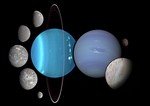Ice Giants Systems 2020
Royal Society
Onwards to the Ice Giants…
The Ice Giants, Uranus and Neptune, are the least explored class of planets in our Solar System, having been visited only once by a passing spacecraft, Voyager 2. These distant Ice Giant Systems may be hiding secrets that could reveal the origins of our Solar System, and are our nearest and best representatives of a type of planet that is commonplace in our universe.
In January 2020, Planetary Scientists from around the world met at London’s prestigious Royal Society for a three-day workshop on the future exploration of the Uranus and Neptune systems. We aimed to shape the key scientific questions that will drive mission planning in the coming decade, aiming to make use of ideal launch opportunities around 2030. You can now download the Full Programme (PDF).
The organisers have prepared a Statement of Meeting Outcomes, capturing the key discussion points of the meeting, and the future strategy for coordination to realise our aims of an ambitious, paradigm-shifting mission to the Ice Giants in the coming decade.
Photographs from the event are being hosted on Flickr, including a group photograph taken on Tuesday 21st January in the Marble Hall of the Royal Society.
The meeting organisers used social media in attempt to generate wider excitement for proposed missions to the Ice Giants. You can view some of the conversations here, and can still get involved via @IcyGiants.
Email updates: for updates, please send an email with the subject “Subscribe” to this address. Your email will only be used for information associated with Ice Giant mission planning and meeting organisation, and you can unsubscribe at any time.

